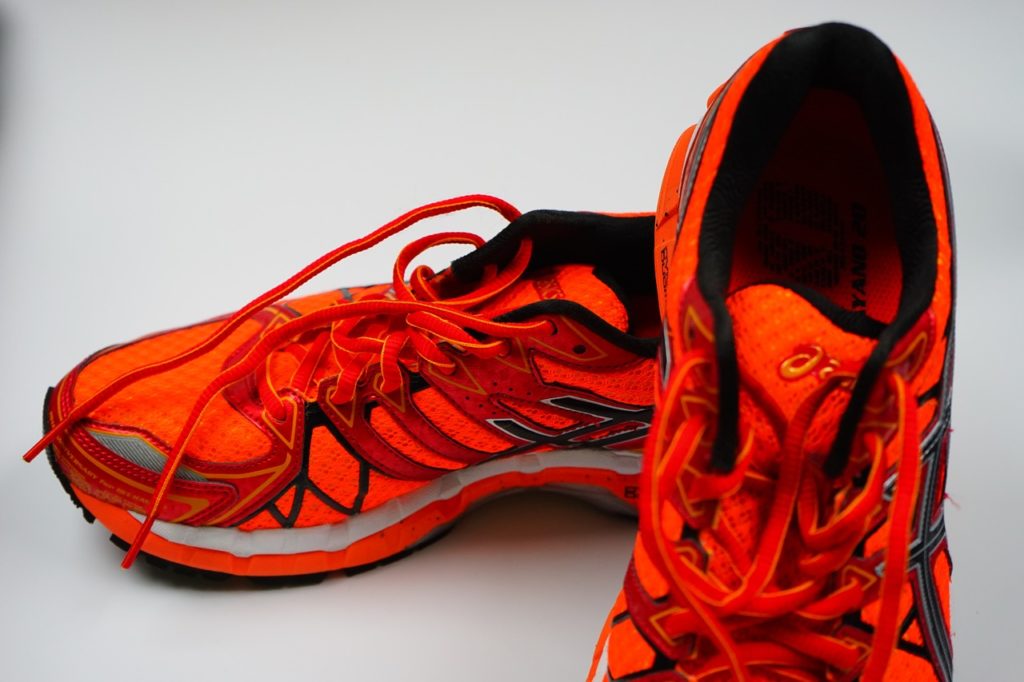 It’s no secret that the right pair of shoes make a world of difference when it comes to preventing or managing the symptoms of Plantar Fasciitis. But which specific qualities should you look for when purchasing a new pair of sneakers for walking, running, or sports?
It’s no secret that the right pair of shoes make a world of difference when it comes to preventing or managing the symptoms of Plantar Fasciitis. But which specific qualities should you look for when purchasing a new pair of sneakers for walking, running, or sports?
Your search for the best running shoes or sneakers for plantar fasciitis should take into account several key factors, including correct sizing, proper lacing, matching your footwear with the activity you’ll be taking part in, budgeting effectively, and fortifying your shoes with additional support.
Click here to get Heel Seats, which turn any sneakers into orthotic shoes!
With the right pair of shoes on your side, you’ll find the support you need for a broader range of activity–and comfort!
Correct Sizing
Did you know that a recent study found that almost one third of participants were wearing the wrong size shoe?
That’s bad news for Plantar Fasciitis sufferers, since shoe size can have a big impact on the condition. Shoes that are too loose can make your stride irregular and put strain on your arches, while cramped footwear can cause your toes to curl and add pressure to your heel and the ball of your foot.
While choosing the correct size shoe for your feet might seem simple–and a no-brainer once you’ve found the right size–it’s not as simple as it might seem. For one thing, shoe size can change with age. In fact, experts estimate that your shoe size can increase by half a size every ten years after you turn 40. It’s also important to consider the width of your feet–not just the length. Weight gain is a common culprit of changes in foot width, since it can cause your feet to flatten and expand. Shoes that are too narrow or too wide won’t give you the support you need, so keep a close gage on how your shoes fit.
Solution: Measure your feet regularly, and often–and make sure that any shoe you buy fits as comfortably at the beginning of the day as it does by the end, when feet are likely to be most swollen. When you buy new shoes, make sure the company has a good return policy, so you’re not stuck with an ill-fitting pair of shoes (it can be hard to get a good gage of fit in the store).
Proper Lacing and Sole Support

The best sneakers for Plantar Fasciitis will have a thick, cushiony sole–a necessity to put a buffer between your heels and fascia, and a hard or uneven surface. A flexible, rubber sole is best (avoid leather) for maximum shock absorption. Keep an eye on your soles as time goes by, since, depending on how much you use them, this sole will wear down and erode over time.
Lacing can also make a difference when it comes to Plantar Fasciitis. The more eyelets on the laces, the better, since this allows you greater control over how loose or tight different parts of the shoe fit on your foot. To get the maximum support of your heel and arch, leave the laces near your toes slightly looser, and the laces near your heels tied tight. For even better heel support, make a small loop with each lace when you get to the second-to-last eyelet, then thread the lace through the last eyelet and back through the loops before tying the laces.
Fit the Shoe to the Activity
As the old saying goes–if the shoe fits, wear it! And when it comes to choosing the best athletic shoes for Plantar Fasciitis, your sneaker of choice should differ depending on the type of activity you’re going to take part in.
While you don’t need a closet full of shoes, having a few different pairs for different types of activities can reduce the strain to your arches and mitigate the symptoms of Plantar Fasciitis more effectively than using just one pair for all activities.
- Walking: Look for a smooth tread, a flexible sole that allows your foot to bend easily, and good cushioning on the soles.
- Running: Look for extra stability in the heel, lightweight structure, and thick flexible cushioning on the soles
- Field Activities: Look for extra ankle support and excellent traction, along with a thick sole
Fit the Shoe to Your Budget
The most expensive sneaker isn’t always the best shoe for Plantar Fasciitis. In fact, buying several pairs of shoes to fit your activity type, and making sure those shoes fit well–and are used in tandem with Heel Seats or Orthotics–is worth more than the most expensive pair of sneakers money can buy. In fact, several studies have found that medium and low cost sneakers perform as well as (or even outperform expensive sneaker brands when it comes to heel and arch support).
If you’re looking for advice on a specific brand recommendation, many experts at the American Orthopaedic Foot and Ankle Society swear by New Balance shoes for their patients (64 percent!) Expect to pay between $35 and $50 for a good pair of sneakers (there are plenty of more expensive options, but don’t buy them on account of your feet–just your sense of style!)




If we bought orthotic inserts from you does it make sense to get a minimalist running shoe to put them in?
Hi Mandy! Since everyone is so different, this is something you’ll have to try out for yourself to figure out :/ If you have very high arches and usually require arch support, we’d recommend against minimalist shoes. However, if you have low or normal arches – with the added plantar fascia support of the Heel Seats – minimalist shoes might be just fine. Hope this helps!
I ordered these things in feb, when do you send another pair
Hi Hattie! If you subscribed for the auto-shipping, you should have received your next pair already. Please email us at [email protected] or give us a call 877-215-3200 with your order number or the approximate date of your purchase and we will get this straightened out for you 🙂
I’m curious about you thong sandal. I love the heel seats, will the sandals give mr the support I need?
I would like to have a list of shoes I can use with your HTP heel seats, since I have to use it, only can use sneakers, and I´d like to use other shoes, but there is no space for the heel seats in other types of shoes. Please help me with that.
Hi Persida! Unfortunately we do not have a specific list of shoes that are compatible with Heel Seats. As you’ve discovered, most sneakers work well. Anything higher-backed shoe should have sufficient room for Heel Seats. If you find that they’re too snug, try loosening the laces of the shoes. For flats and sandals, try Heel Seat Wraps: https://heelthatpain.com/treatments/heel-seat-wraps/
Hope this helps!
both plantars bad for a year now all my trainers seem to be narrow just had riods are sketchers any good
I have a heel spur and have had two cordorsone shots with no pain relief what with you sujest and I stand on my feet for 18 hour a week and I tape my heels what can I do